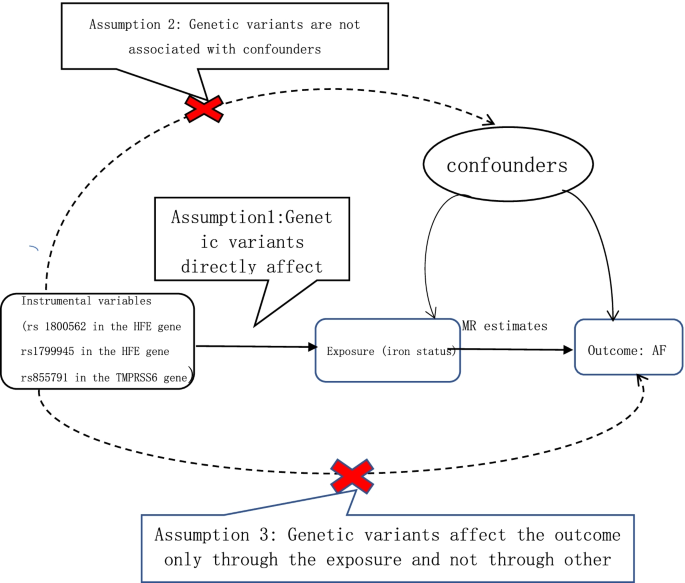Genetic support of a causal relationship between iron status and atrial fibrillation: a Mendelian randomization study
IF 3.5
3区 医学
Q1 Medicine
引用次数: 3
Abstract
Atrial fibrillation is the most common arrhythmia disease. Animal and observational studies have found a link between iron status and atrial fibrillation. However, the causal relationship between iron status and AF remains unclear. The purpose of this investigation was to use Mendelian randomization (MR) analysis, which has been widely applied to estimate the causal effect, to reveal whether systemic iron status was causally related to atrial fibrillation. Single nucleotide polymorphisms (SNPs) strongly associated (P < 5 × 10−8) with four biomarkers of systemic iron status were obtained from a genome-wide association study involving 48,972 subjects conducted by the Genetics of Iron Status consortium. Summary-level data for the genetic associations with atrial fibrillation were acquired from the AFGen (Atrial Fibrillation Genetics) consortium study (including 65,446 atrial fibrillation cases and 522,744 controls). We used a two-sample MR analysis to obtain a causal estimate and further verified credibility through sensitivity analysis. Genetically instrumented serum iron [OR 1.09; 95% confidence interval (CI) 1.02–1.16; p = 0.01], ferritin [OR 1.16; 95% CI 1.02–1.33; p = 0.02], and transferrin saturation [OR 1.05; 95% CI 1.01–1.11; p = 0.01] had positive effects on atrial fibrillation. Genetically instrumented transferrin levels [OR 0.90; 95% CI 0.86–0.97; p = 0.006] were inversely correlated with atrial fibrillation. In conclusion, our results strongly elucidated a causal link between genetically determined higher iron status and increased risk of atrial fibrillation. This provided new ideas for the clinical prevention and treatment of atrial fibrillation.

铁状态和房颤之间因果关系的遗传支持:孟德尔随机研究
心房颤动是最常见的心律失常疾病。动物和观察性研究已经发现了铁状态和房颤之间的联系。然而,铁状态与房颤之间的因果关系尚不清楚。本研究的目的是使用孟德尔随机化(MR)分析来揭示全身铁状态是否与房颤有因果关系,孟德尔随机化(MR)分析已被广泛应用于估计因果关系。在一项涉及48,972名受试者的全基因组关联研究中,由遗传铁状态联盟(Genetics of iron status consortium)获得了与四种全身铁状态生物标志物密切相关(P < 5 × 10−8)的单核苷酸多态性(SNPs)。房颤遗传关联的概要数据来自AFGen(房颤遗传学)联合研究(包括65,446例房颤病例和522,744例对照)。我们使用双样本MR分析获得因果估计,并通过敏感性分析进一步验证可信性。基因检测血清铁[OR 1.09;95%置信区间(CI) 1.02 ~ 1.16;p = 0.01],铁蛋白[OR 1.16;95% ci 1.02-1.33;p = 0.02],转铁蛋白饱和度[OR 1.05;95% ci 1.01-1.11;P = 0.01]对房颤有积极作用。基因检测转铁蛋白水平[OR 0.90;95% ci 0.86-0.97;P = 0.006]与房颤呈负相关。总之,我们的研究结果有力地阐明了基因决定的高铁状态和房颤风险增加之间的因果关系。这为房颤的临床防治提供了新的思路。
本文章由计算机程序翻译,如有差异,请以英文原文为准。
求助全文
约1分钟内获得全文
求助全文
来源期刊

Genes and Nutrition
Biochemistry, Genetics and Molecular Biology-Genetics
CiteScore
7.90
自引率
0.00%
发文量
14
审稿时长
13 weeks
期刊介绍:
This journal examines the relationship between genetics and nutrition, with the ultimate goal of improving human health. It publishes original research articles and review articles on preclinical research data coming largely from animal, cell culture and other experimental models as well as critical evaluations of human experimental data to help deliver products with medically proven use.
 求助内容:
求助内容: 应助结果提醒方式:
应助结果提醒方式:


